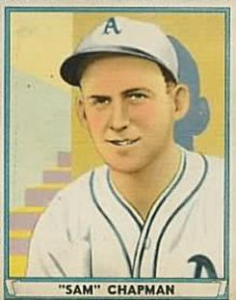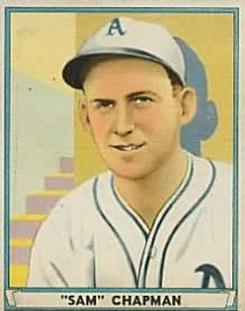August 15, 1946: Sam Chapman wallops three homers
 Of all the games played at Shibe Park, few were more unusual or less predictable than the meeting on August 15, 1946, between the Boston Red Sox and the Philadelphia Athletics. It was a game in which a woeful team beat the best in the league in an upset of mammoth proportions.
Of all the games played at Shibe Park, few were more unusual or less predictable than the meeting on August 15, 1946, between the Boston Red Sox and the Philadelphia Athletics. It was a game in which a woeful team beat the best in the league in an upset of mammoth proportions.
The game pitted the American League’s first-place Red Sox, at the time the owners of a 79-33 record and a 13½-game lead over the second-place New York Yankees, against the last place Athletics, who took the field with a 32-79 record while trailing Boston by 46½ games. The A’s were in the midst of a dreadful period during which they had finished in last place in eight of the previous 11 seasons.
Boston fielded a star-studded lineup that included future Hall of Famers Ted Williams and Bobby Doerr, plus Dom DiMaggio, Johnny Pesky, and Rudy York. Williams would go on to capture the American League’s Most Valuable Player Award that season while hitting .342 with 38 home runs, 123 RBIs, and a league-leading 142 runs scored. Pesky would finish with a .335 batting average and DiMaggio hit .316.
The Athletics fielded a team that featured Barney McCosky, Elmer Valo, Sam Chapman, Hank Majeski, Pete Suder, and Buddy Rosar. None was in quite the same class as the Red Sox stars, although McCosky (.354) and Valo (.307) hit well in 1946 in less than full-time service.
Going into the August 15 game, the Red Sox, who had the best record in baseball, had won nine of their previous 11 outings, including a three-game sweep of the Athletics a week earlier in Boston. The Red Sox had 11 more wins than the next winningest team in the majors (Brooklyn Dodgers). Meanwhile, the Athletics, managed by Connie Mack in his 46th year at the helm and holding the worst record in baseball with 11 fewer wins than the next worst team (Pittsburgh Pirates), entered the three-game series having lost 10 of their last 12 games. Prior to that, the A’s had lost nine straight games in late May, and at one point in July lost 13 of 15 games.
Manager Joe Cronin’s Red Sox were victorious in the first two games of the series at Shibe Park, 7-5 and 3-1. In the third game, played on a Thursday afternoon, Boston sent to the mound Joe Dobson, one of its top pitchers and the owner of an 11-5 record. Dobson was a right-hander who would go on to post a 13-7 season record during what would become a 14-year big-league career on the mound and a 137-103 won-lost record. His opponent was husky 235-pound Luther “Lou” Knerr, a highly undistinguished right-handed hurler, who had posted a 2-13 record up to that point after going just 5-11 in his rookie year during a short-term big-league career.
But the A’s had Chapman in the lineup. Although he was batting sixth, Chapman would be responsible for giving the game one of the more unexpected outcomes since Shibe Park opened in 1909.
Chapman had been an All-American football player at the University of California, was drafted by the Washington Redskins, and would later be elected to the College Football Hall of Fame. A shortstop and second baseman in high school and college, Chapman decided to pursue a career in baseball rather than football, and had been recommended to Mack by Ty Cobb, who had seen him play as a youth in his native California. Mack then signed Chapman, although other teams had been interested in signing the young player, too.
After his rookie season in 1938, Chapman had been converted to an outfielder, and in 1941 had what would be the best season of his career, hitting .322 with 25 home runs and 106 RBIs. But after the season he had enlisted in the military and would become a Navy pilot during World War II.
Chapman returned to Philadelphia at the end of the 1945 season after spending nearly four years in the service. Like so many other veterans, he was still trying to regain his playing skills in 1946 when he was selected to the American League All-Star team at midseason.
“That year was a very special time,” Chapman told this writer many years later. “The fans were great. They were happy to see us back, and they applauded everybody. It took a while to get back into the swing of things, but it was a grand year. It was good to be back.”1
It was especially good on that quiet afternoon in 1946. With just 5,642 in attendance, Chapman, playing left field, hit a home run with one out in the second inning to give the A’s a 1-0 lead.
But with the Athletics’ ineptitude clearly on display, Boston stepped out to a 3-1 lead in the third inning. With one out, Roy Partee singled. Then Dobson dropped a bunt, which third baseman Majeski threw wildly to first. When the ball flew into right field, Valo bobbled it, allowing Partee to score and Dobson to reach third base. A single by Tom McBride drove Dobson home. Pesky, and DiMaggio followed with singles with McBride scoring on the latter’s hit to put the Red Sox ahead by two runs.
In the bottom of the fourth inning, the Red Sox’ lead was erased. With one out Suder, normally a second baseman but playing shortstop in this game, walked. Chapman followed with another home run to tie the score at 3-3.
That twosome was back in business in the eighth inning when they hit back-to-back homers. With one out, Suder, who had a career-high .281 batting average in 1946 but who was typically not a home-run hitter (he hit homers in double figures just once during a 13-year career in the majors), slammed a pitch out of the park. Then Chapman followed with another homer to knock Dobson out of the game and give the A’s a 5-3 lead. Chapman’s homer was the last of seven hits in the game for the Athletics.
The lead held as Knerr set down the Red Sox in the ninth inning. While allowing just six hits, walking two, and striking out six, the right-handed hurler posted his third and final victory of the season. (He would go on to lose 16.) It would be his last – and only eighth overall – major-league victory in a big-league career that was over early the following year.
Meanwhile, Chapman, who would play in the majors through 1951, finished with a .261 batting average and 67 RBIs for the season. His 20 home runs represented one-half of the Athletics’ entire total that year.
“It was a game I’ll never forget,” he recalled. “Fortunately, Shibe Park was a good hitter’s park. It was laid out nicely and small enough that you could get a home run. But it was big enough that you couldn’t hit one out all the time.”2
Only two players in the majors hit three home runs in one game that season. The other was Williams, who was hitless in four trips to the plate in the A’s upset victory.
As it turned out, the Athletics posted a 10-7 home record in August, the only month of the season in which they had a winning mark at home. They went on to finish the campaign with a 49-105 record, 55 games out of first place. The Red Sox, who won nine of their next 13 games after the stunning loss to the A’s, ended the season with a 104-50 record, 12 games ahead of the second-place Detroit Tigers. That earned the Red Sox a trip to the World Series, which they lost in seven games to the St. Louis Cardinals.
Until that point in the season, though, the most memorable Red Sox loss occurred on that August 15 day when a team that was by far the worst in baseball beat the club with the best regular-season mark in the big leagues. By the way, the time of that game was 1 hour and 37 minutes. That was just as unbelievable as the mind-boggling final score.
SOURCES
In addition to the sources cited in the Notes, the author accessed Retrosheet.org, Baseball-Reference.com, and SABR.org.
NOTES
1 Rich Westcott, Masters of the Diamond, Interviews with Players Who Began Their Careers More Than 50 Years Ago (Jefferson, North Carolina: McFarland & Co., 1994), 22.
2 Westcott, 25.
Additional Stats
Philadelphia Athletics 5
Boston Red Sox 3
Shibe Park
Philadelphia, PA
Box Score + PBP:
Corrections? Additions?
If you can help us improve this game story, contact us.


